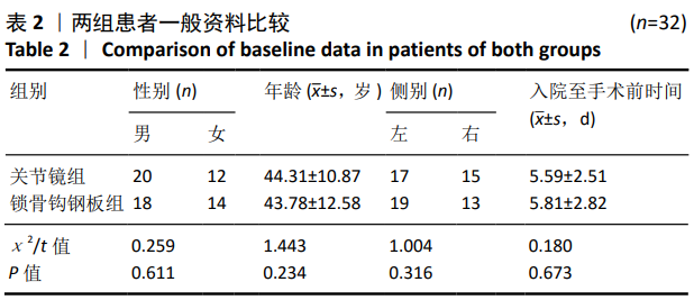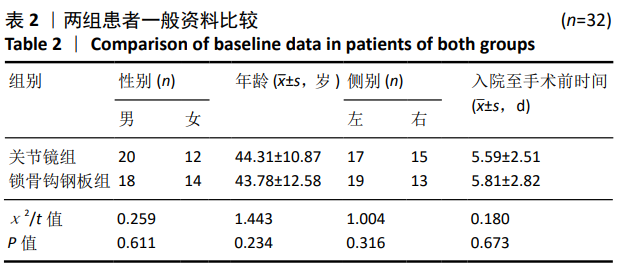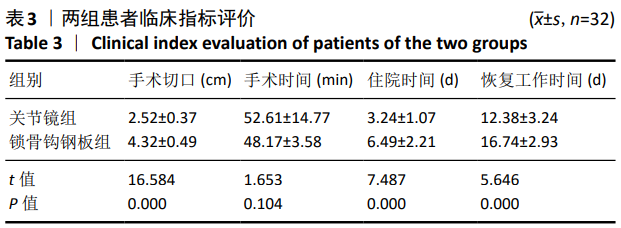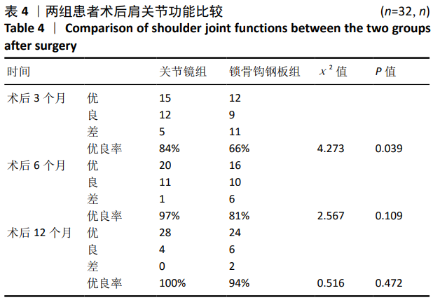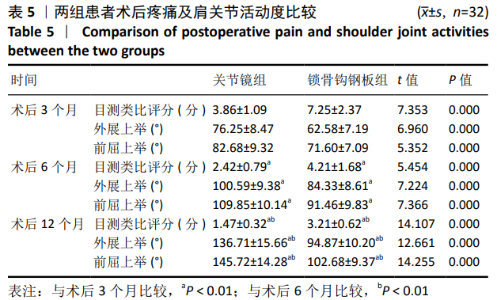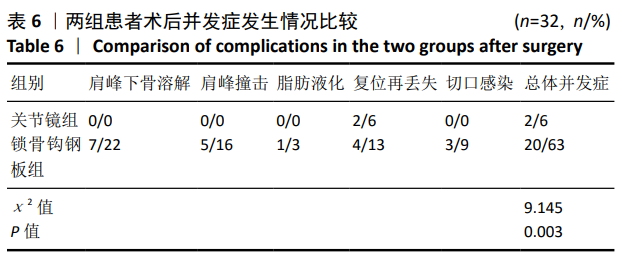Chinese Journal of Tissue Engineering Research ›› 2021, Vol. 25 ›› Issue (9): 1417-1422.doi: 10.3969/j.issn.2095-4344.3764
Previous Articles Next Articles
Arthroscopic suture bridge technique with suture anchor in the treatment of acromioclavicular dislocation
Zhang Shangpu1, Ju Xiaodong2, Song Hengyi1, Dong Zhi1, Wang Chen1, Sun Guodong1
- 1Department of Orthopedics, General Hospital of Jizhong Energy Xingtai Mining Group, Xingtai 054000, Hebei Province, China; 2Institute of Sports Medicine, Peking University Third Hospital, Beijing 100191, China
-
Received:2020-06-16Revised:2020-06-19Accepted:2020-07-20Online:2021-03-28Published:2020-12-16 -
Contact:Ju Xiaodong, MD, Associate chief physician, Institute of Sports Medicine, Peking University Third Hospital, Beijing 100191, China -
About author:Zhang Shangpu, Master, Associate chief physician, Department of Orthopedics, General Hospital of Jizhong Energy Xingtai Mining Group, Xingtai 054000, Hebei Province, China -
Supported by:the key Scientific and Technological Research Plan of Medical Science Research Project in Hebei Province, No. 20191644
CLC Number:
Cite this article
Zhang Shangpu, Ju Xiaodong, Song Hengyi, Dong Zhi, Wang Chen, Sun Guodong. Arthroscopic suture bridge technique with suture anchor in the treatment of acromioclavicular dislocation[J]. Chinese Journal of Tissue Engineering Research, 2021, 25(9): 1417-1422.
share this article
| [1] NORDIN JS, OLSSON O, LUNSJÖ K. Acromioclavicular joint dislocations: incidence, injury profile, and patient characteristics from a prospective case series. JSES Int. 2020;4(2):246‐250. [2] MAHAJAN RH, KUMAR S, MISHRA BP. Grade 3 AC joint injury: A survey of current practice in the United Kingdom. J Orthop Surg (Hong Kong). 2019;27(1): 2309499018825222. [3] MARTETSCHLÄGER F, KRAUS N, SCHEIBEL M, et al. The Diagnosis and Treatment of Acute Dislocation of the Acromioclavicular Joint. Dtsch Arztebl Int. 2019; 116(6):89-95. [4] COOK JB, KRUL KP. Challenges in Treating Acromioclavicular Separations: Current Concepts. J Am Acad Orthop Surg. 2018;26(19):669-677. [5] QI W, XU Y, YAN Z, et al. The tight-rope technique versus clavicular hook plate for treatment of acute acromioclavicular joint dislocation: a systematic review and meta-analysis. J Invest Surg. 2019;1‐10. [6] 胡阿威,夏成焱,夏春明,等.锁骨钩钢板与双Endobutton钢板治疗肩锁关节脱位的疗效比较[J]. 临床骨科杂志,2017,20(1):111-113. [7] LU D, WANG T, HONG JJ, et al. Acute acromioclavicular joint dislocation treated with tightrope : Mini-open versus percutaneous stabilization. Acta Orthop Belg. 2019;85(4):406‐411. [8] GAYTÁN-FERNÁNDEZ S, BLANCO-OCHOA LC, BARRAGÁN-HERVELLA RG, et al. Acromioclavicular dislocation management with use of Tight Rope luxation acromioclavicular con Tight Rope. Acta Ortop Mex. 2019;33(5):314‐318. [9] MAZIAK N, AUDIGE L, HANN C, et al. Factors Predicting the Outcome After Arthroscopically Assisted Stabilization of Acute High-Grade Acromioclavicular Joint Dislocations. Am J Sports Med. 2019;47(11):2670‐2677. [10] RANNE JO, KAINONEN TU, LEHTINEN JT, et al. Arthroscopic Coracoclavicular Ligament Reconstruction of Chronic Acromioclavicular Dislocations Using Autogenous Semitendinosus Graft: A Two-Year Follow-up Study of 58 Patients. Arthrosc Sports Med Rehabil. 2020;2(1):e7‐e15. [11] CAMPAGNA V, PICCINNI V, ROTUNDO G, et al. The Kite technique: a new all-arthroscopic technique for the treatment of acute acromioclavicular joint dislocation [published online ahead of print, 2020 Apr 25]. Knee Surg Sports Traumatol Arthrosc. 2020;10.1007/s00167-020-06013-5. [12] 张尚普,郑淑慧,董智,等.带线锚钉结合缝线桥技术治疗Tossy Ⅲ型肩锁关节脱位的可行性及安全性分析[J].河北医药,2020,42(09):1332-1335. [13] YE JK, YU BJ, YE FS, et al. Case-control study on therapeutic effects between modified weaver-dunn surgery and clavicular hook plate fixation in the treatment of acromioclavicular joint dislocation. Zhongguo Gu Shang. 2014;27(1):4‐8. [14] 刘松,秦士吉,张英泽. 肩锁关节脱位的手术治疗进展[J].中华创伤骨科杂志, 2013,15(4):349-351. [15] HELFEN T, SIEBENBÜRGER G, OCKERT B, et al. Therapy of acute acromioclavicular joint instability. Meta-analysis of arthroscopic/minimally invasive versus open procedures. Unfallchirurg. 2015;118(5):415‐426. [16] CISNEROS LN, REIRIZ JS. Management of acute unstable acromioclavicular joint injuries. Eur J Orthop Surg Traumatol. 2016;26(8):817‐830. [17] KUMAR N, SHARMA V. Hook plate fixation for acute acromioclavicular dislocations without coracoclavicular ligament reconstruction: a functional outcome study in military personnel. Strategies Trauma Limb Reconstr. 2015;10(2):79e85. [18] ARIRACHAKARAN A, BOONARD M, PIYAPITTAYANUN P, et al. Post-operative outcomes and complications of suspensory loop fixation device versus hook plate in acute unstable acromioclavicular joint dislocation: a systematic review and meta-analysis. J Orthop Traumatol. 2017;18(4):293‐304. [19] 周勇伟,杨骐宁,李晓飞,等.关节镜辅助Tightrope钢板与锁骨钩钢板内固定治疗成人RockwoodⅢ型肩锁关节脱位的疗效比较[J].中华创伤骨科杂志, 2019,21(5):446-449. [20] 梁广权.肩锁关节脱位的治疗进展[J].微创医学,2017,12(2):240-242. [21] 张传开,韩冰,冯晖,等.双带线锚钉重建喙锁韧带治疗Tossy Ⅲ型肩锁关节脱位的生物力学研究与临床[J].中国矫形外科杂志,2015,23(10):932-936. [22] 吴昊,罗辉耀,朱冬承,等.带线锚钉加关节囊钻孔缝合法治疗肩锁关节脱位[J].实用骨科杂志,2017,23(1):53-55. [23] ALLEMANN F, HALVACHIZADEH S, WALDBURGER M, et al. Different treatment strategies for acromioclavicular dislocation injuries: a nationwide survey on open/minimally invasive and arthroscopic concepts. Eur J Med Res. 2019;24(1):18. [24] 谢福杰,孙春汉,钟浩博,等.关节镜下袢钢板治疗急性肩锁关节脱位疗效分析[J].实用骨科杂志,2019,25(3):250-253. [25] LIU X, HUANGFU X, ZHAO J. Arthroscopic treatment of acute acromioclavicular joint dislocation by coracoclavicular ligament augmentation. Knee Surg Sports Traumatol Arthrosc. 2015;23(5):1460‐1466. [26] PEETERS I, HERREGODTS S, DE WILDE L, et al. Biomechanical evaluation of a new technique for acromioclavicular stabilization. Orthop Traumatol Surg Res. 2020;106(2):247‐254. [27] JEONG JY, YOO YS, LEE SJ, et al. Arthroscopic coracoclavicular fixation technique using multiple all-suture anchors. Arthrosc Tech. 2019;8(4):e423‐e427. [28] NOLTE PC, LACHETA L, DEKKER TJ, et al. Optimal Management of Acromioclavicular Dislocation: Current Perspectives. Orthop Res Rev. 2020;12:27‐44. [29] JENSEN G, MILLETT PJ, TAHAL DS, et al. Concomitant glenohumeral pathologies associated with acute and chronic grade III and grade V acromioclavicular joint injuries. Int Orthop. 2017;41(8):1633‐1640. [30] RUIZ IBÁN MA, MORENO ROMERO MS, DIAZ HEREDIA J, et al. The prevalence of intraarticular associated lesions after acute acromioclavicular joint injuries is 20%. A systematic review and meta-analysis. Knee Surg Sports Traumatol Arthrosc. 2020.doi: 10.1007/s00167-020-05917-6. [31] XIONG C, LU Y, WANG Q, et al. Anatomical principles for minimally invasive reconstruction of the acromioclavicular joint with anchors. Int Orthop. 2016; 40(11):2317‐2324. [32] LÄDERMANN A, GUEORGUIEV B, STIMEC B, et al. Acromioclavicular joint reconstruction: a comparative biomechanical study of three techniques. J Shoulder Elbow Surg. 2013;22(2):171‐178. [33] LI Q, HSUEH PL, CHEN YF. Coracoclavicular ligament reconstruction: a systematic review and a biomechanical study of a triple endobutton technique. Medicine (Baltimore). 2014;93(28):e193. [34] TORKAMAN A, BAGHERIFARD A, MOKHATRI T, et al. Double-button fixation system for management of acute acromioclavicular joint dislocation. Arch Bone Jt Surg. 2016;4(1):41‐46. [35] HASHIGUCHI H, IWASHITA S, ABE K, et al. Arthroscopic Coracoclavicular Ligament Reconstruction for Acromioclavicular Joint Dislocation. J Nippon Med Sch. 2018; 85(3):166‐171. [36] SIRCANA G, SACCOMANNO MF, MOCINI F, et al. Anatomic reconstruction of the acromioclavicular joint provides the best functional outcomes in the treatment of chronic instability. Knee Surg Sports Traumatol Arthrosc. 2020.doi: 10.1007/s00167-020-06059-5. [37] MAIER D, JAEGER M, REISING K, et al. Injury patterns of the acromioclavicular ligament complex in acute acromioclavicular joint dislocations: a cross-sectional, fundamental study. BMC Musculoskelet Disord. 2016;17(1):385. [38] 王勤业,罗亚平,徐忠良.肩锁关节脱位的治疗[J].实用骨科杂志,2008, 14(12):736-738. [39] 朱小广,彭庆州,吴宏伟.带线锚钉与锁骨钩板内固定治疗Neer Ⅱ型锁骨远端骨折的疗效比较[J].中国骨与关节损伤杂志,2016,31(5):535-536. [40] SUN LJ, LU D, TAO ZY, et al. Analysis of risk factors for loss of reduction after acromioclavicular joint dislocation treated with the suture-button. J Orthop Sci. 2019;24(5):817‐821. [41] 郭志民,张萌,上官天丞,等.锁骨钩钢板固定术后肩峰切割2例[J].临床骨科杂志,2016,19(3):309. [42] 孙辽军. Suture-button治疗急性肩锁关节脱位术后复位丢失的危险因素分析及相关危险因素的生物力学验证[D].广州:南方医科大学,2018. [43] 王秀会,崔煦,王明辉,等.TightRope治疗RockwoodⅢ型肩锁关节脱位失败病例分析[J].中华肩肘外科电子杂志,2019,7(1):44-49. [44] 赵立连,卢明峰,许挺,等.关节镜下双Endobutton钮扣钢板内固定治疗急性肩锁关节脱位[J].中华创伤杂志,2019,35(1):71-78. [45] ZHANG CK, LIU C, HAN B, et al. CT Measurement and Clinical Application of Double-Row Suture Anchor Reconstruction for the Treatment of Tossy Type III Acromioclavicular Joint Dislocation. Zhongguo Gu Shang. 2017;30(4):353‐355. [46] WYLIE JD, JOHNSON JD, DIVENERE J, et al. Shoulder Acromioclavicular and Coracoclavicular Ligament Injuries: Common Problems and Solutions. Clin Sports Med. 2018;37(2):197‐207. [47] ZHANG JW, LI M, HE XF, et al. Operative treatment of acromioclavicular joint dislocation: a new technique with suture anchors. Chin J Traumatol. 2014;17(4): 187‐192. [48] BARTH J, DUPARC F, ANDRIEU K, et al. Is coracoclavicular stabilisation alone sufficient for the endoscopic treatment of severe acromioclavicular joint dislocation (Rockwood types III, IV, and V)? Orthop Traumatol Surg Res. 2015; 101(8 Suppl):S297‐S303. |
| [1] | Xu Feng, Kang Hui, Wei Tanjun, Xi Jintao. Biomechanical analysis of different fixation methods of pedicle screws for thoracolumbar fracture [J]. Chinese Journal of Tissue Engineering Research, 2021, 25(9): 1313-1317. |
| [2] | Jiang Yong, Luo Yi, Ding Yongli, Zhou Yong, Min Li, Tang Fan, Zhang Wenli, Duan Hong, Tu Chongqi. Von Mises stress on the influence of pelvic stability by precise sacral resection and clinical validation [J]. Chinese Journal of Tissue Engineering Research, 2021, 25(9): 1318-1323. |
| [3] | Zhang Tongtong, Wang Zhonghua, Wen Jie, Song Yuxin, Liu Lin. Application of three-dimensional printing model in surgical resection and reconstruction of cervical tumor [J]. Chinese Journal of Tissue Engineering Research, 2021, 25(9): 1335-1339. |
| [4] | Zhang Yu, Tian Shaoqi, Zeng Guobo, Hu Chuan. Risk factors for myocardial infarction following primary total joint arthroplasty [J]. Chinese Journal of Tissue Engineering Research, 2021, 25(9): 1340-1345. |
| [5] | Wei Wei, Li Jian, Huang Linhai, Lan Mindong, Lu Xianwei, Huang Shaodong. Factors affecting fall fear in the first movement of elderly patients after total knee or hip arthroplasty [J]. Chinese Journal of Tissue Engineering Research, 2021, 25(9): 1351-1355. |
| [6] | Wang Jinjun, Deng Zengfa, Liu Kang, He Zhiyong, Yu Xinping, Liang Jianji, Li Chen, Guo Zhouyang. Hemostatic effect and safety of intravenous drip of tranexamic acid combined with topical application of cocktail containing tranexamic acid in total knee arthroplasty [J]. Chinese Journal of Tissue Engineering Research, 2021, 25(9): 1356-1361. |
| [7] | Xiao Guoqing, Liu Xuanze, Yan Yuhao, Zhong Xihong. Influencing factors of knee flexion limitation after total knee arthroplasty with posterior stabilized prostheses [J]. Chinese Journal of Tissue Engineering Research, 2021, 25(9): 1362-1367. |
| [8] | Huang Zexiao, Yang Mei, Lin Shiwei, He Heyu. Correlation between the level of serum n-3 polyunsaturated fatty acids and quadriceps weakness in the early stage after total knee arthroplasty [J]. Chinese Journal of Tissue Engineering Research, 2021, 25(9): 1375-1380. |
| [9] | Zhang Chong, Liu Zhiang, Yao Shuaihui, Gao Junsheng, Jiang Yan, Zhang Lu. Safety and effectiveness of topical application of tranexamic acid to reduce drainage of elderly femoral neck fractures after total hip arthroplasty [J]. Chinese Journal of Tissue Engineering Research, 2021, 25(9): 1381-1386. |
| [10] | Wang Haiying, Lü Bing, Li Hui, Wang Shunyi. Posterior lumbar interbody fusion for degenerative lumbar spondylolisthesis: prediction of functional prognosis of patients based on spinopelvic parameters [J]. Chinese Journal of Tissue Engineering Research, 2021, 25(9): 1393-1397. |
| [11] | Lü Zhen, Bai Jinzhu. A prospective study on the application of staged lumbar motion chain rehabilitation based on McKenzie’s technique after lumbar percutaneous transforaminal endoscopic discectomy [J]. Chinese Journal of Tissue Engineering Research, 2021, 25(9): 1398-1403. |
| [12] | Chen Xinmin, Li Wenbiao, Xiong Kaikai, Xiong Xiaoyan, Zheng Liqin, Li Musheng, Zheng Yongze, Lin Ziling. Type A3.3 femoral intertrochanteric fracture with augmented proximal femoral nail anti-rotation in the elderly: finite element analysis of the optimal amount of bone cement [J]. Chinese Journal of Tissue Engineering Research, 2021, 25(9): 1404-1409. |
| [13] | Du Xiupeng, Yang Zhaohui. Effect of degree of initial deformity of impacted femoral neck fractures under 65 years of age on femoral neck shortening [J]. Chinese Journal of Tissue Engineering Research, 2021, 25(9): 1410-1416. |
| [14] | Liang Yan, Zhao Yongfei, Xu Shuai, Zhu Zhenqi, Wang Kaifeng, Liu Haiying, Mao Keya. Imaging evaluation of short-segment fixation and fusion for degenerative lumbar scoliosis assisted by highly selective nerve root block [J]. Chinese Journal of Tissue Engineering Research, 2021, 25(9): 1423-1427. |
| [15] | Zhou Jihui, Li Xinzhi, Zhou You, Huang Wei, Chen Wenyao. Multiple problems in the selection of implants for patellar fracture [J]. Chinese Journal of Tissue Engineering Research, 2021, 25(9): 1440-1445. |
| Viewed | ||||||
|
Full text |
|
|||||
|
Abstract |
|
|||||


